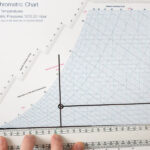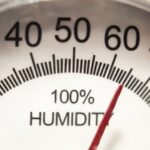Wet bulb temperature is easily measured with a standard thermometer which has its sensing bulb encased in a wetted wick that is subjected to rapid air motion across its surface. Such devices, called sling or whirled psychrometers, have a frame that can be whirled in the air by hand. When the sling psychrometer whirls through the air, water from the wetted sack evaporates, causing it to cool to the wet-bulb temperature. The amount of cooling that occurs depends on the relative humidity. The lower the humidity, the faster will be the evaporation, and the more the bulb will cool. High humidity will cause less evaporation, slowing the cooling process.
An accurate wet-bulb temperature reading depends on 1) sensitivity and accuracy of the thermometer, 2) maintenance of an adequate air speed past the wick, 3) shielding of the thermometer from radiation, 4) use of distilled or de-ionized water to wet the wick, and 5) use of a cotton wick.
The thermometer sensitivity required to determine an accurate humidity varies according to the temperature range of the air. More sensitivity is needed at low than at high temperatures. For example, at 150°F a 1°F error in wet-bulb temperature reading results in a 2.6 percent error in relative humidity determination, but at 32°F that same error results in a 10.5 percent error in relative humidity.
The rate of evaporation from the wick is a function of air speed past it. A minimum air speed of about 500 feet per minute is required for accurate readings. An air speed much below this will result in an erroneously high wet-bulb reading. Wet-bulb devices that do not provide a guaranteed air flow cannot be relied on to give an accurate reading.
As with the dry-bulb thermometer, sources of radiant heat such as motors, lights, and so on can affect the wet-bulb thermometer. The reading must be taken in an area protected from these sources of radiation or thermometers must be shielded from radiant energy.
A buildup of salts from impure water or contaminants in the air affects the rate of water evaporation from the wick and results in erroneous data. Distilled or de-ionized water should be used to moisten the wick and the wick should be replaced if there is any sign of contamination. The wick material should not have been treated with chemicals such as sizing compounds that affect the water evaporation rate.
Special care must be taken when using a wet-bulb thermometer when the wet-bulb temperature is near freezing. Most humidity tables and calculators are based on a frozen wick at wet-bulb temperatures below 32°F. At temperatures below 32°F, touch the wick with a piece of clean ice or another cold object to induce freezing, because distilled water can be cooled below 32°F without freezing. The psychrometric chart or calculator must use frost-bulb, not wet-bulb temperatures, below 32°F to be accurate with this method.


